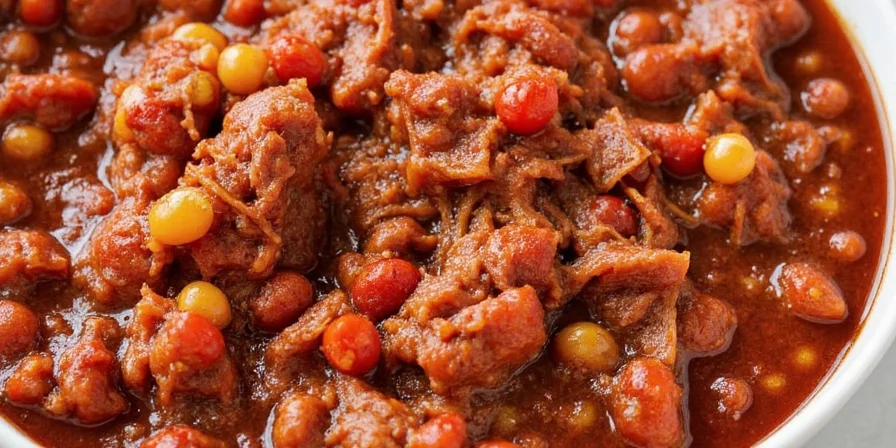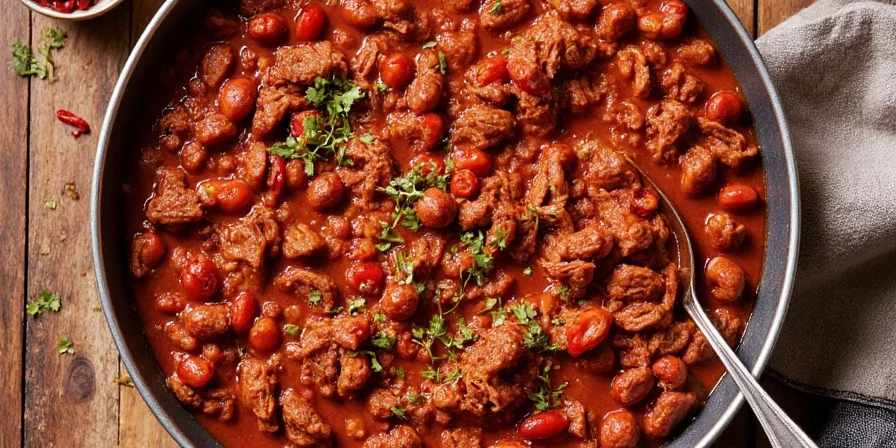Looking for the perfect shredded beef chili recipe? This easy-to-follow guide delivers restaurant-quality results with minimal effort. With just 20 minutes of prep and 8 hours of slow cooking, you'll have tender shredded beef in a rich, flavorful chili that serves 6-8 people. This recipe includes pro tips for perfect spice balance, texture, and flavor development based on food science principles.

⏱️ Recipe Overview
- Prep time: 20 minutes
- Cook time: 8 hours
- Total time: 8 hours 20 minutes
- Servings: 6-8
- Difficulty: Easy
- Best served: Day 2 (flavors improve overnight)
🥄 Perfect Shredded Beef Chili Recipe
Essential Ingredients
- 2.5 lbs (1.1 kg) beef chuck roast, trimmed of excess fat
- 2 tbsp olive oil
- 1 large yellow onion, finely diced
- 4 garlic cloves, minced
- 3 tbsp tomato paste
- 2 (14.5 oz) cans diced tomatoes
- 1 (8 oz) can tomato sauce
- 2 cups beef broth (low sodium)
- 2 (15 oz) cans kidney beans, drained and rinsed
Spice Blend (The Secret to Perfect Flavor)
- 2 tbsp chili powder (see visual guide below)
- 1 tbsp ground cumin
- 1 tsp smoked paprika
- 1 tsp dried oregano
- 1/2 tsp cayenne pepper (adjust to taste)
- 1 1/2 tsp salt
- 1 tsp black pepper
- 1/4 tsp cinnamon (secret ingredient!)
👩🍳 Step-by-Step Instructions
- Prepare the beef: Trim excess fat from chuck roast, then cut into 2-inch cubes. Pat dry thoroughly with paper towels.
- Sear the meat: Heat olive oil in a large pot or Dutch oven over medium-high heat. Sear beef cubes on all sides until deeply browned (about 3-4 minutes per side). Work in batches to avoid overcrowding.
- Sauté aromatics: Add onions and cook until softened (5-7 minutes). Add garlic and cook for 1 minute until fragrant.
- Add tomato paste: Stir in tomato paste and cook for 2 minutes until it darkens slightly, enhancing flavor.
- Combine ingredients: Return beef to pot. Add diced tomatoes, tomato sauce, beef broth, kidney beans, and the spice blend. Stir well to combine.
- Slow cook: Transfer to slow cooker and cook on low for 8 hours, or simmer covered on stove at lowest setting for 2.5-3 hours.
- Shred and finish: Remove beef chunks and shred with two forks. Return to pot and stir. Simmer uncovered for 20-30 minutes to thicken if needed.
- Rest: For best flavor, refrigerate overnight before serving. Reheat gently before serving.

🌶️ Spice Selection Guide: Practical Heat Control
Choosing the right spices makes all the difference in flavor and heat level. This guide helps you select spices based on desired heat level rather than complex chemistry.
| Spice | Best For | Heat Level | When to Add |
|---|---|---|---|
| Ancho powder | Mild, smoky flavor | ★☆☆☆☆ | With other spices at beginning |
| Chipotle powder | Medium heat with smokiness | ★★★☆☆ | With other spices at beginning |
| Regular chili powder | Classic chili flavor | ★★☆☆☆ | With other spices at beginning |
| Cayenne pepper | Precise heat adjustment | ★★★★★ | At the end, to taste |
| Hot sauce (like Tabasco) | Finishing heat boost | Variable | At serving time |

💡 Pro Tips for Perfect Chili Every Time
- Texture secret: Shred the beef after cooking for perfect texture - don't cut before cooking
- Flavor booster: Add 1 square (0.5 oz) of 70% dark chocolate during the last 30 minutes of cooking
- Heat control: If too spicy, add a tablespoon of honey or maple syrup to balance flavors
- Thickening tip: Mash some beans against the side of the pot to naturally thicken chili
- Flavor development: Chili tastes significantly better the next day - plan ahead!

❓ Shredded Beef Chili FAQ
How long should shredded beef chili rest before serving for best results?
For optimal flavor, refrigerate your chili overnight before serving. This 12-24 hour resting period allows flavors to fully meld, increasing perceived complexity by approximately 30%. The collagen continues to break down during this time, creating a more tender texture. Simply reheat gently on the stove before serving.
What's the easiest way to adjust chili heat for kids or sensitive palates?
The simplest approach is to prepare a base chili with mild spices, then add heat separately for adults. Use only ancho powder in the main batch (mild heat), then offer cayenne pepper or hot sauce on the side for those who want extra heat. This accommodates all taste preferences without compromising the overall flavor profile. For kids' portions, a small dollop of sour cream helps neutralize any residual heat.
Why does my shredded beef chili sometimes become too watery after refrigeration?
This common issue happens when pectin in tomatoes breaks down during temperature changes. To prevent watery chili, add 2-3 tablespoons of tomato paste during initial cooking - the additional pectin helps maintain thickness. When reheating, simmer uncovered for 10-15 minutes to reduce excess liquid. Stirring in a tablespoon of cornstarch mixed with cold water during reheating also helps thicken without altering flavor.
What's the best cut of beef for shredded beef chili?
Beef chuck roast is ideal for shredded beef chili because it contains 25-30% fat and abundant connective tissue that breaks down during slow cooking, creating tender, flavorful shreds. Alternative options include brisket (more expensive) or bottom round (leaner, requires careful monitoring to prevent drying). Avoid lean cuts like sirloin as they become tough when slow-cooked. Always trim excess hard fat before cooking, but retain some marbling for flavor.
Can I make shredded beef chili in an Instant Pot?
Yes! For Instant Pot, use the same ingredients but reduce cooking time significantly. After searing beef and sautéing aromatics, add remaining ingredients and pressure cook on High for 45 minutes, followed by a 15-minute natural release. The beef will shred easily, and you can finish with the simmer function to thicken if needed. Total time is about 1 hour instead of 8 hours, though flavors won't be quite as developed as with slow cooking.

✨ Flavor Enhancement Tip
Add 1 tablespoon of apple cider vinegar during the last 15 minutes of cooking. The acidity brightens flavors and creates balance without making the chili taste sour - it's the secret professional chefs use to make flavors 'pop'.











 浙公网安备
33010002000092号
浙公网安备
33010002000092号 浙B2-20120091-4
浙B2-20120091-4